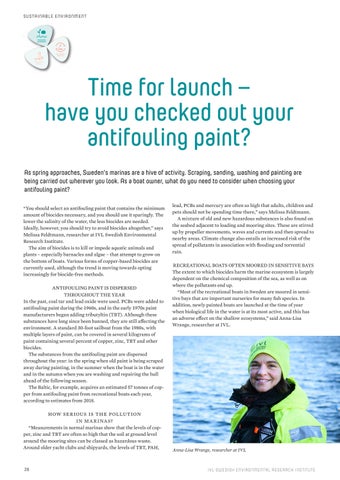SUSTAI NABLE ENVI R ON M E NT
Sustainable environment
Sustainable transition Sustainable society
Time for launch – have you checked out your antifouling paint? As spring approaches, Sweden’s marinas are a hive of activity. Scraping, sanding, washing and painting are being carried out wherever you look. As a boat owner, what do you need to consider when choosing your antifouling paint? “You should select an antifouling paint that contains the minimum amount of biocides necessary, and you should use it sparingly. The lower the salinity of the water, the less biocides are needed. Ideally, however, you should try to avoid biocides altogether,” says Melissa Feldtmann, researcher at IVL Swedish Environmental Research Institute. The aim of biocides is to kill or impede aquatic animals and plants – especially barnacles and algae – that attempt to grow on the bottom of boats. Various forms of copper-based biocides are currently used, although the trend is moving towards opting increasingly for biocide-free methods. ANTIFOULING PAINT IS DISPERSED THROUGHOUT THE YEAR In the past, coal tar and lead oxide were used. PCBs were added to antifouling paint during the 1960s, and in the early 1970s paint manufacturers began adding tributyltin (TBT). Although these substances have long since been banned, they are still affecting the environment. A standard 30-foot sailboat from the 1980s, with multiple layers of paint, can be covered in several kilograms of paint containing several percent of copper, zinc, TBT and other biocides. The substances from the antifouling paint are dispersed throughout the year: in the spring when old paint is being scraped away during painting, in the summer when the boat is in the water and in the autumn when you are washing and repairing the hull ahead of the following season. The Baltic, for example, acquires an estimated 57 tonnes of copper from antifouling paint from recreational boats each year, according to estimates from 2018. HOW SE R IOUS IS T H E P OL LU T ION I N M A R I NA S? “Measurements in normal marinas show that the levels of copper, zinc and TBT are often so high that the soil at ground level around the mooring sites can be classed as hazardous waste. Around older yacht clubs and shipyards, the levels of TBT, PAH,
26
lead, PCBs and mercury are often so high that adults, children and pets should not be spending time there,” says Melissa Feldtmann. A mixture of old and new hazardous substances is also found on the seabed adjacent to loading and mooring sites. These are stirred up by propeller movements, waves and currents and then spread to nearby areas. Climate change also entails an increased risk of the spread of pollutants in association with flooding and torrential rain. RECREATIONAL BOATS OFTEN MOORED IN SENSITIVE BAYS The extent to which biocides harm the marine ecosystem is largely dependent on the chemical composition of the sea, as well as on where the pollutants end up. “Most of the recreational boats in Sweden are moored in sensitive bays that are important nurseries for many fish species. In addition, newly painted boats are launched at the time of year when biological life in the water is at its most active, and this has an adverse effect on the shallow ecosystems,” said Anna-Lisa Wrange, researcher at IVL.
Anna-Lisa Wrange, researcher at IVL
IVL SWEDISH ENVIRONMENTAL RESEARCH INSTITUTE































